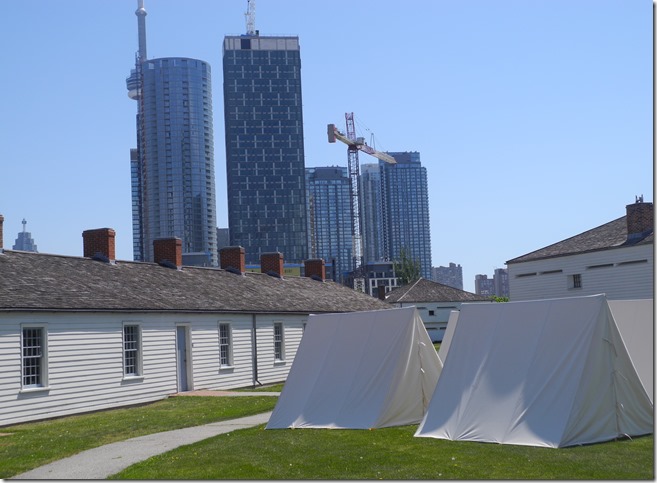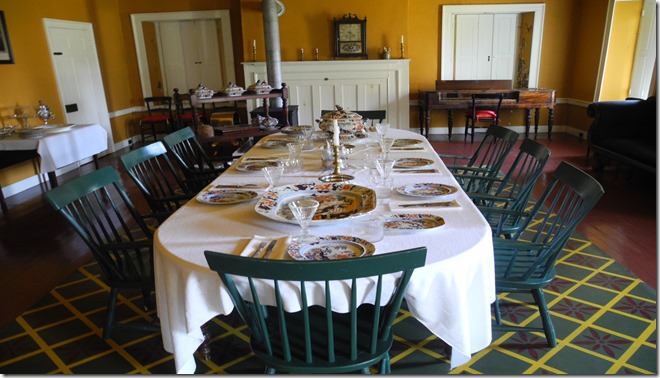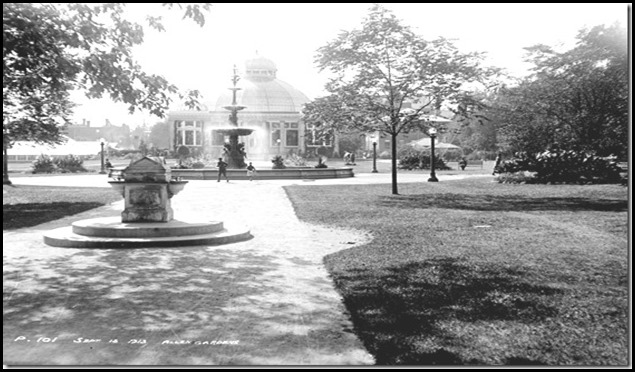Gazing eastward to the entrance to the old Fort at York on April 10, 1909. City of Toronto Archives, Fl.1548, S0343, It. 1737(1).
On July 21, 1793, one hundred soldiers of the Queen’s Rangers, under the command of Captain Aenaeus Shaw, commenced constructing fortifications to defend the site against an American invasion. It consisted of logs, both the buildings and the palisade. This structure was destroyed during the Battle of York in April 1813, during the War of 1812. When the powder magazine exploded, there was great loss of life, including the American commander. In the weeks following the attack, the British commenced rebuilding. In August 1814, the fort was of sufficient strength that it thwarted an attack by an American naval squadron. The war ended in 1815 and work to rebuild the fort continued.
The rebuilt fortification remained in use until 1841, when troops were relocated from the old fort to the Stanley Barracks, southwest of the old fort. One of the buildings of the Stanley Barracks remains today, located within the CNE grounds. Shortly after confederation, in 1870, the Canadian government took control of the nation’s defences. Fort York then became its responsibility.
In 1909, control of the older fort was ceded to the City of Toronto. However, the fort continued to be used for training troops. The military abandoned the fort in the early 1930s, To commemorate the city’s 100th year, it was restored, providing much needed employment during the Great Depression. On Victoria Day in 1934, it was officially opened by the governor general of Canada as an historic site and museum.
Today, Fort York is surrounded by the ever-increasing towers of the city’s downtown. The building on the left in the above photo is the barracks constructed in 1814 to accommodate up to eight unmarried junior officers. Married officers usually lived outside in the town. The mess and dining room for all the officers were in this building. In its basement were two vaults that secured government and personal funds.
On the right is blockhouse number two, built in 1813 to house 160 men. The roof was heavily reinforced and there was a small gunpowder magazine in the cellar. Its thick timbered walls protected the men from bullets and exploding shells. Until the 1820, the only way to enter the blockhouse was by a door on the second floor, the stairs to it raised if the blockhouse were under attack. This prevented enemy forces from entering the building. The building in the distant, partially hidden by the tents, is blockhouse number one. Built in 1813, the second floor of this structure also overhangs the floor below. The tents were erected for an historical re-enactment in the fort.
Dining room in the officer’s barracks.
To view the Home Page for this blog: https://tayloronhistory.com/
To view previous blogs about movie houses of Toronto—historic and modern
Recent publication entitled “Toronto’s Theatres and the Golden Age of the Silver Screen,” by the author of this blog. The publication explores 50 of Toronto’s old theatres and contains over 80 archival photographs of the facades, marquees and interiors of the theatres. It relates anecdotes and stories of the author and others who experienced these grand old movie houses.
To place an order for this book:
Book also available in Chapter/Indigo, the Bell Lightbox Book Store and by phoning University of Toronto Press, Distribution: 416-667-7791
Theatres Included in the Book:
Chapter One – The Early Years—Nickelodeons and the First Theatres in Toronto
Theatorium (Red Mill) Theatre—Toronto’s First Movie Experience and First Permanent Movie Theatre, Auditorium (Avenue, PIckford), Colonial Theatre (the Bay), the Photodrome, Revue Theatre, Picture Palace (Royal George), Big Nickel (National, Rio), Madison Theatre (Midtown, Capri, Eden, Bloor Cinema, Bloor Street Hot Docs), Theatre Without a Name (Pastime, Prince Edward, Fox)
Chapter Two – The Great Movie Palaces – The End of the Nickelodeons
Loew’s Yonge Street (Elgin/Winter Garden), Shea’s Hippodrome, The Allen (Tivoli), Pantages (Imperial, Imperial Six, Ed Mirvish), Loew’s Uptown
Chapter Three – Smaller Theatres in the pre-1920s and 1920s
Oakwood, Broadway, Carlton on Parliament Street, Victory on Yonge Street (Embassy, Astor, Showcase, Federal, New Yorker, Panasonic), Allan’s Danforth (Century, Titania, Music Hall), Parkdale, Alhambra (Baronet, Eve), St. Clair, Standard (Strand, Victory, Golden Harvest), Palace, Bedford (Park), Hudson (Mount Pleasant), Belsize (Crest, Regent), Runnymede
Chapter Four – Theatres During the 1930s, the Great Depression
Grant ,Hollywood, Oriole (Cinema, International Cinema), Eglinton, Casino, Radio City, Paramount, Scarboro, Paradise (Eve’s Paradise), State (Bloordale), Colony, Bellevue (Lux, Elektra, Lido), Kingsway, Pylon (Royal, Golden Princess), Metro
Chapter Five – Theatres in the 1940s – The Second World War and the Post-War Years
University, Odeon Fairlawn, Vaughan, Odeon Danforth, Glendale, Odeon Hyland, Nortown, Willow, Downtown, Odeon Carlton, Donlands, Biltmore, Odeon Humber, Town Cinema
Chapter Six – The 1950s Theatres
Savoy (Coronet), Westwood
Chapter Seven – Cineplex and Multi-screen Complexes
Cineplex Eaton Centre, Cineplex Odeon Varsity, Scotiabank Cineplex, Dundas Square Cineplex, The Bell Lightbox (TIFF)



![cid_E474E4F9-11FC-42C9-AAAD-1B66D852[2] cid_E474E4F9-11FC-42C9-AAAD-1B66D852[2]](https://tayloronhistory.com/wp-content/uploads/2015/05/cid_e474e4f9-11fc-42c9-aaad-1b66d8522_thumb.jpg)

